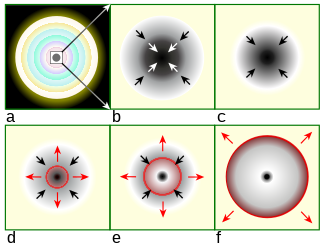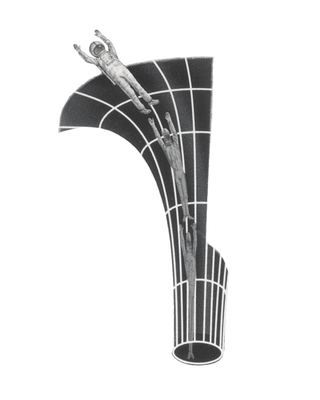
A black hole is a region of spacetime where gravity is so strong that nothing, including light and other electromagnetic waves, has enough energy to escape it. Einstein's theory of general relativity predicts that a sufficiently compact mass can deform spacetime to form a black hole. The boundary of no escape is called the event horizon. A black hole has a great effect on the fate and circumstances of an object crossing it, but it has no locally detectable features according to general relativity. In many ways, a black hole acts like an ideal black body, as it reflects no light. Moreover, quantum field theory in curved spacetime predicts that event horizons emit Hawking radiation, with the same spectrum as a black body of a temperature inversely proportional to its mass. This temperature is of the order of billionths of a kelvin for stellar black holes, making it essentially impossible to observe directly.

General relativity, also known as the general theory of relativity and Einstein's theory of gravity, is the geometric theory of gravitation published by Albert Einstein in 1915 and is the current description of gravitation in modern physics. General relativity generalises special relativity and refines Newton's law of universal gravitation, providing a unified description of gravity as a geometric property of space and time or four-dimensional spacetime. In particular, the curvature of spacetime is directly related to the energy and momentum of whatever matter and radiation are present. The relation is specified by the Einstein field equations, a system of second order partial differential equations.

A gravitational singularity, spacetime singularity or simply singularity is a condition in which gravity is predicted to be so intense that spacetime itself would break down catastrophically. As such, a singularity is by definition no longer part of the regular spacetime and cannot be determined by "where" or "when". Gravitational singularities exist at a junction between general relativity and quantum mechanics; therefore, the properties of the singularity cannot be described without an established theory of quantum gravity. Trying to find a complete and precise definition of singularities in the theory of general relativity, the current best theory of gravity, remains a difficult problem. A singularity in general relativity can be defined by the scalar invariant curvature becoming infinite or, better, by a geodesic being incomplete.
Timeline of black hole physics
Hawking radiation is the theoretical thermal black-body radiation released outside a black hole's event horizon. This is counterintuitive because once ordinary electromagnetic radiation is inside the event horizon, it cannot escape. It is named after the physicist Stephen Hawking, who developed a theoretical argument for its existence in 1974. Hawking radiation is predicted to be extremely faint and is many orders of magnitude below the current best telescopes' detecting ability.
The Schwarzschild radius or the gravitational radius is a physical parameter in the Schwarzschild solution to Einstein's field equations that corresponds to the radius defining the event horizon of a Schwarzschild black hole. It is a characteristic radius associated with any quantity of mass. The Schwarzschild radius was named after the German astronomer Karl Schwarzschild, who calculated this exact solution for the theory of general relativity in 1916.
In general relativity, a white hole is a hypothetical region of spacetime and singularity that cannot be entered from the outside, although energy-matter, light and information can escape from it. In this sense, it is the reverse of a black hole, from which energy-matter, light and information cannot escape. White holes appear in the theory of eternal black holes. In addition to a black hole region in the future, such a solution of the Einstein field equations has a white hole region in its past. This region does not exist for black holes that have formed through gravitational collapse, however, nor are there any observed physical processes through which a white hole could be formed.
The Penrose–Hawking singularity theorems are a set of results in general relativity that attempt to answer the question of when gravitation produces singularities. The Penrose singularity theorem is a theorem in semi-Riemannian geometry and its general relativistic interpretation predicts a gravitational singularity in black hole formation. The Hawking singularity theorem is based on the Penrose theorem and it is interpreted as a gravitational singularity in the Big Bang situation. Penrose was awarded the Nobel Prize in Physics in 2020 "for the discovery that black hole formation is a robust prediction of the general theory of relativity", which he shared with Reinhard Genzel and Andrea Ghez.

Gravitational collapse is the contraction of an astronomical object due to the influence of its own gravity, which tends to draw matter inward toward the center of gravity. Gravitational collapse is a fundamental mechanism for structure formation in the universe. Over time an initial, relatively smooth distribution of matter, after sufficient accretion, may collapse to form pockets of higher density, such as stars or black holes.
Micro black holes, also called mini black holes or quantum mechanical black holes, are hypothetical tiny black holes, for which quantum mechanical effects play an important role. The concept that black holes may exist that are smaller than stellar mass was introduced in 1971 by Stephen Hawking.
Fuzzballs are a hypothetical object in superstring theory, intended to provide a fully quantum description of the black holes predicted by general relativity.
In physics, there is a speculative hypothesis that, if there were a black hole with the same mass, charge and angular momentum as an electron, it would share other properties of the electron. Most notably, Brandon Carter showed in 1968 that the magnetic moment of such an object would match that of an electron. This is interesting because calculations ignoring special relativity and treating the electron as a small rotating sphere of charge give a magnetic moment roughly half the experimental value.

Black Holes & Time Warps: Einstein's Outrageous Legacy is a 1994 popular science book by physicist Kip Thorne. It provides an illustrated overview of the history and development of black hole theory, from its roots in Newtonian mechanics until the early 1990s.
A ring singularity or ringularity is the gravitational singularity of a rotating black hole, or a Kerr black hole, that is shaped like a ring.

In astrophysics, spaghettification is the vertical stretching and horizontal compression of objects into long thin shapes in a very strong, non-homogeneous gravitational field. It is caused by extreme tidal forces. In the most extreme cases, near a black hole, the stretching and compression are so powerful that no object can resist it. Within a small region, the horizontal compression balances the vertical stretching so that a small object being spaghettified experiences no net change in volume.
A black star is a gravitational object composed of matter. It is a theoretical alternative to the black hole concept from general relativity. The theoretical construct was created through the use of semiclassical gravity theory. A similar structure should also exist for the Einstein–Maxwell–Dirac equations system, which is the (super) classical limit of quantum electrodynamics, and for the Einstein–Yang–Mills–Dirac system, which is the (super) classical limit of the standard model.
In astrophysics, an event horizon is a boundary beyond which events cannot affect an observer. Wolfgang Rindler coined the term in the 1950s.

In astrophysics, an extreme mass ratio inspiral (EMRI) is the orbit of a relatively light object around a much heavier object, that gradually spirals in due to the emission of gravitational waves. Such systems are likely to be found in the centers of galaxies, where stellar mass compact objects, such as stellar black holes and neutron stars, may be found orbiting a supermassive black hole. In the case of a black hole in orbit around another black hole this is an extreme mass ratio binary black hole. The term EMRI is sometimes used as a shorthand to denote the emitted gravitational waveform as well as the orbit itself.
In loop quantum gravity theory, a Planck star is a hypothetical astronomical object, theorized as a compact, exotic star, that exists within a black hole's event horizon, created when the energy density of a collapsing star reaches the Planck energy density. Under these conditions, assuming gravity and spacetime are quantized, a repulsive "force" arises from Heisenberg's uncertainty principle. The accumulation of mass–energy inside the Planck star cannot collapse beyond this limit because it violates the uncertainty principle for spacetime itself.








